 Thanks: 0
 Likes: 0
 Dislikes: 0
-
Re: Boat detailing must haves
I know that some guys are painting gel-coat with Imron, but I'm not so sure that this system is the best for gel-coats over a gel-coat specific paint system such as those one and two part urethane and polyurethane systems from Awlgrip, Petit, Interlux and others. Why? Gel-coats and their underlying substrates are subject to extreme stresses that automotive paint systems don't necessarily see.
Hang tight while I await a phone call from experts. I'm also going to take a drive tomorrow to speak to a man who uses the automotive Imron systems on his many gel-coat projects.
Below is post (starting with the quote and then my follow-up thoughts)I debated on posting. I've decided to go ahead and give my thoughts on the matter before speaking to those "in-the-know". Give me a few days and we'll see what kind of information we get, and I'll pass it along.
 Originally Posted by Whatsvtec

I've worked on more than 1 base/clear, so just check to see if the owner knows. A good way to check is by taking some rubbing compound on a towel and seeing if color from the gelcoat comes off when you rub the compound on the the spot of color.
Sent from my DROID4 using Tapatalk 2
Something doesn't add up about the above statements.
I'll start with the following:
A white or "other colored" gel-coat surface, once oxidized can/will leave a similar color of oxidation transfered to a cloth after rubbing. This colored oxidation that was removed, in and of itself, does not mean a boat has been painted, rather, it (the colored gel-coat which has color all the way through it, or the gel-coat is clear) simply oxidized. My point; a base/coat clear coat paint system (which I'm not aware exists) should not rub any color off onto a towel no more than it would on a car. Why? Simple...the clear layer is the top layer and the base color would be underneath. IF this were possible to see a color on your rag with a base/clear paint system, then the top clear layer would be compromised. Meaning, there's a hole in the top clear layer, which is a significant problem.
I would also be worried about a basecoat/clearcoat paint system failing in a fiberglass/gelcoated surface because of being too brittle, i.e., not flexible enough for the stresses placed on the entire structures of a boat.
Please note that I am in no way saying that a basecoat/clearcoat paint system doesn't exist for boats, rather, that I am not aware of their existance.
I am aware of enamel topside paint systems (several brands), Urethane topside paint systems (Awlgrip), one-part mono and two-part urethane topside paint systems (Epifanes), one-part ad two-part polyurethanes (Interlux, Petit, etc).
Awlgrip does offer a urethane topcoat as well as base colors, as well as a high gloss clear. While this may clear can be added over a base color using the Awlgrip brand, that still leaves the clear layer on top. Therefore, if you take a rag to check to see if you will get paint transfer, if any transfer happens, it should be from an oxidized clear top layer, and NOT the base color transfering on the rag, towel, etc. However, a boat can be painted, oxidize, and have resuling colored residue come off on a rag, but this boat will not have clear on it.
So yes, boat topsides can be and are painted at times. Some may even come painted from the factory, though I can't be sure of this. I have been around 45'-50' Fountain racing boats that had colored gel-coat with zero paint that I am aware of. I've also seen custom paint jobs on those same Fountain racing boats that cost in excess of $100,000 dollars just for the paint and special effects in the paint job itself.
I'm not a paint expert, nor am I a boat/car guru. However, based upon a semi-educated guess, I don't think that we can just simply throw around terms such as "basecoat/clearcoat" expecting those paints to be the same for both automobiles and boats. A car/truck, at least in my mind, doesn't even come close to seeing the same stresses on it's body panels as a boat does on its hull and topsides, which are structurally tied together rather than siimply being bolted on (yes I know the tops are seperate from the bottoms, yet are tied together).
In short,
Non-painted gel-coat can be many colors. Oxidation can and will transfer that particular color onto a rag when oxidized.
A painted gel-coat can also transfer color to a rag if the color isn't topped with clear.
A painted gel-coat with a base color and a clear gloss top layer will also transfer oxidation, but it should be a powdery and more "milky" looking grime on your rag, NOT the base color.
Again, I am seeking definite answers from professionals...and the phone just wrang. Hang tight...
Last edited by Hoytman; 02-28-2013 at 03:43 PM.
Bill
-
Re: Boat detailing must haves
 Originally Posted by bulldog shine

Mike gave me great advice. Meg's 50, it is a cleaner/wax. It worked great on a boat I just did.
Take the above advice...
 Originally Posted by MikeN

All I know is that the boat is a 25 footer,
And apply it here... the point being, when buffing out large boats if you can do the job with a one-step cleaner/wax and get acceptable to great results it means only going around the boat one time.
If you need to compound, polish and wax... and the boat is 24' long, that's a lot of buffing and wiping... then you still have to do the other side.
 Originally Posted by MikeN

What's the difference in the detailing process?
Many marine products intended to be used on a gel-coat surface are to harsh or too aggressive for use on a thin, delicate clear coat paint system.
I shared a lot of before, process and after pictures when I buffed out my 1967 Starline Deville in which the orange gel-coat had tuned chalky white in places due to neglect.
1967 Starline Deville - Extreme Makeover
1967 Starline Deville Family Ski Boat with a brand new Bimini Top in matching orange Sunbrella material. They guy that built this lives in Hesperia and has been making customer Bimini tops for around 40 years. The bows are all Stainless Steel so they won't flex, bend or rust.

The Plexiglas windshield is original, with no cracks or crazing, and in mint condition.
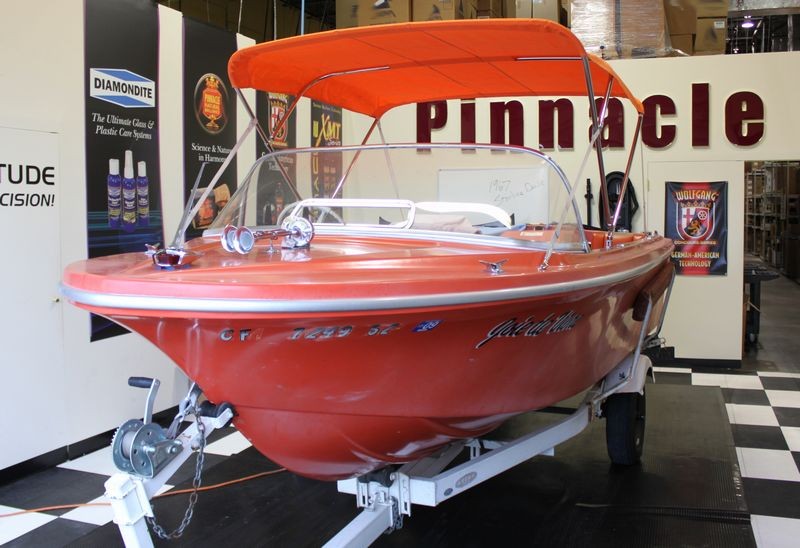

Severe oxidation

I had a tarp covering the boat and you can see a line where the tarp ended; you can also see how the gel-coat that's not covered has oxidized more than the rest of the boat after only a few weeks exposed to Florida weather.
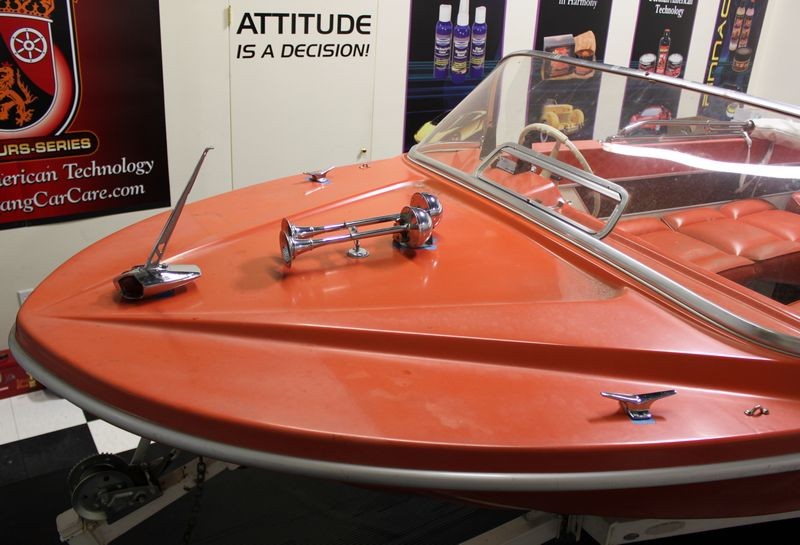
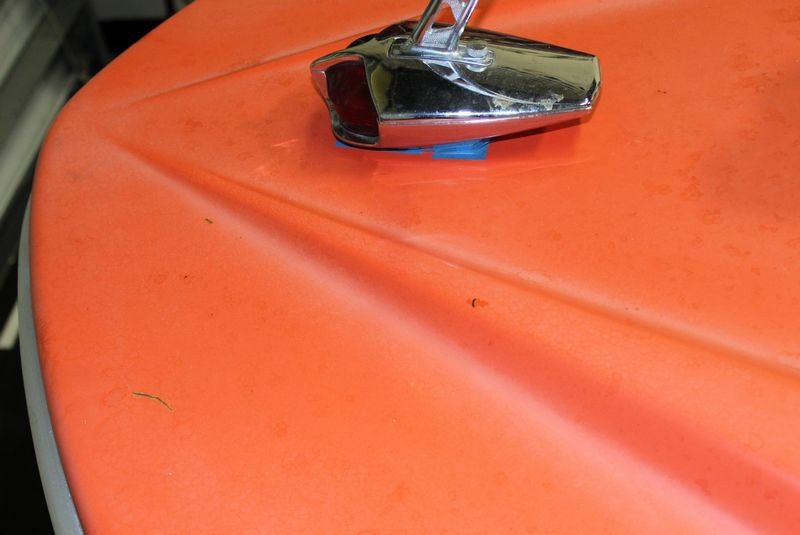
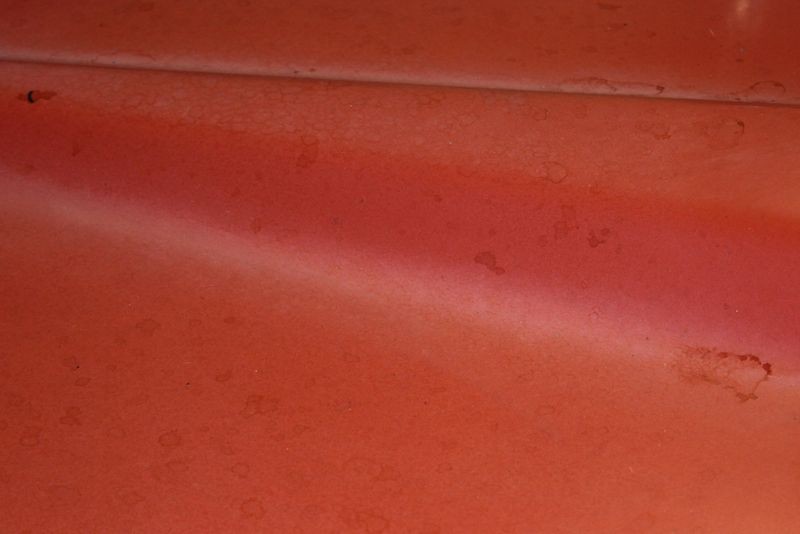
Lot's of oxidation on the rear of the boat. The Meguiar's apron was torn so it's now being used as a shield for another before & after section. To the right you can see a diagonal taped-off section and this is where I'm going to do my machine test spot using the XMT #4
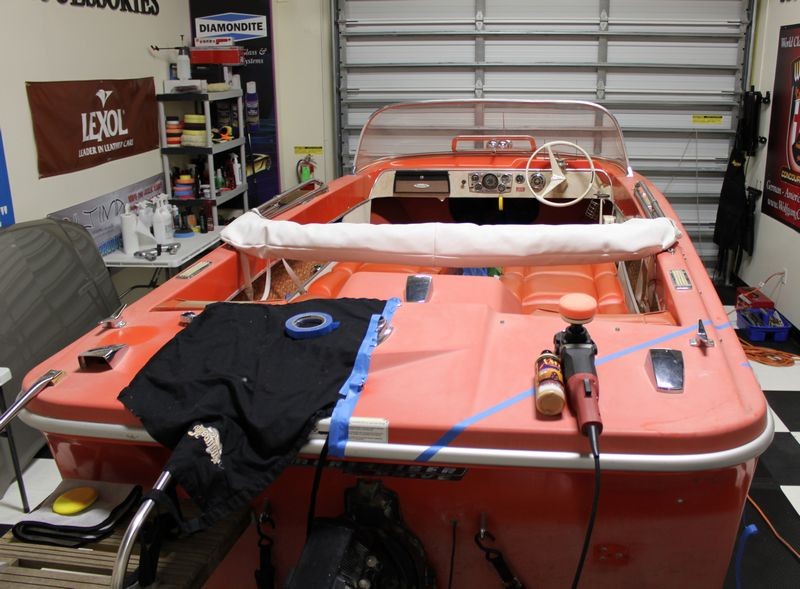
Look at the gel-coat below the water line! It's like this all the way around the lower hull of the boat.

__________________
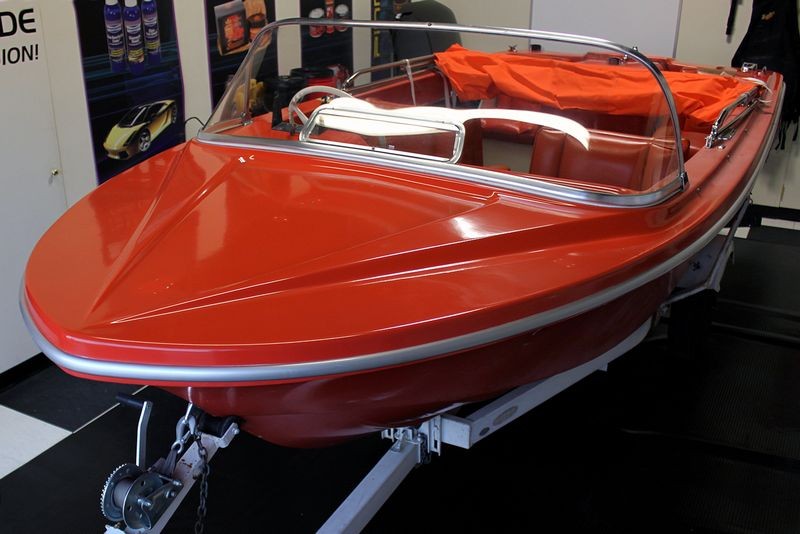
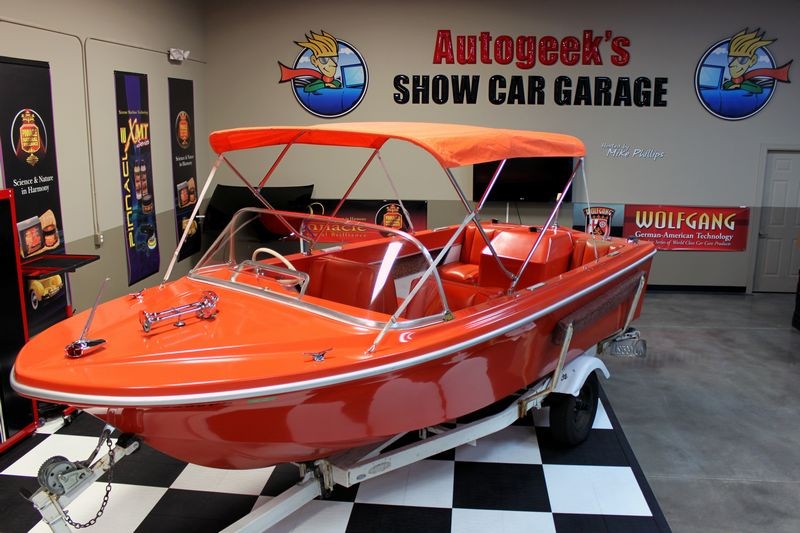
After the Maiden Voyage...
Maiden Voyage - 1967 Starline Deville in Stuart, Florida


-
Re: Boat detailing must haves
Talked to Matt (tech specialist) at Jamestown distributors today. He confirmed, as did my auto paint supply store, that many boats indeed are painted with Imron basecoat/clearcoat. I did not realized this, but Matt indicated (as did my automotive paint supplier)that a marine paint system is best when considering painting a boat, because of flexing issues. Both parties confirmed that the lifespan is much shorter with an automotive basecoat clear system as they tend to start cracking.
Matt said that even the highest end paint jobs are one type of paint system, which calls for 5-8 coats of this paint (no base other than primer), which offers an extreme amount of gloss, according to Matt. He also mentioned these are mono and two-part polyurathane paint systems designed for use on gel-coat and offer high gloss on their own without a clear "paint" on top. Specifically he mentioned Awlgrip sytsems, and Interlux...which also happened to be brands that they sell. Take that for what it is.
These paint systems he mentioned over time will also begin to fade and will begin to transfer the paint color onto a rag when they begin to oxidize, which he said if properly maintained, should last as high as 15 years. That's pretty impressive considering lifespan of an Imron basecoat/clearcoat system on gel-coat that both parties indicated would only last 5-7 years under ideal conditions and hard use. No doubt there are many factors to consider when evaluating lifespans of a particular paint system on gel-coat.
I have one more guy to talk to that is local that does large boat refinishing...and I'm doing this mostly for my own knowledge and simply passing along what I learn for others to take it or leave it...and then I've got some other contacts on the Great Lakes that can assist me.
I'm sure there are lots of differing opinions on what is best. I'll have to take into consideration each and every bit of knowledge that is shared with me and weigh it against what others share with me.
Just keep in mind that unless a clear coat has failed, and unless it is a tinted clear coat, either on a boat or a car, there should be no color transfer that I'm aware of...because it's clear. Tinted clear may offer a little color transfer when it's oxidized.
One of my assumptions above was wrong.
It does appear that some people who paint boats indeed use the terms "basecoat/clearcoat" when they talk about painting boats. Keep in mind that it's an automotive paint system applied to a marine application. So, I stand corrected, and by my own research none-the-less. I've learned quite a bit today, and that's always good. Just thought I'd pass some of it along. Sorry to have taken this thread so far off subject.
Mr. Phillips,
Just looking at the photo's and comments above you had me conviced that you removed all of that oxidation on that old orange boat with just M50 cleaner wax. I thought, wow...that's impressive...until I read the article on it. I had never seen that entire thread.
I've heard you talk about how good xmt#4 is a cutting heavy oxidation, but did end up having a preference of products that seemed to produce the greatest results on that boat? Gel-coat surfaces today seem to be much more smooth in terms of texture, which offer greater DOI. That did turn out sweet didn't it. That orange just pops and looks awesome for its age.
-
 Originally Posted by Hoytman

I know that some guys are painting gel-coat with Imron, but I'm not so sure that this system is the best for gel-coats over a gel-coat specific paint system such as those one and two part urethane and polyurethane systems from Awlgrip, Petit, Interlux and others. Why? Gel-coats and their underlying substrates are subject to extreme stresses that automotive paint systems don't necessarily see.
Hang tight while I await a phone call from experts. I'm also going to take a drive tomorrow to speak to a man who uses the automotive Imron systems on his many gel-coat projects.
Below is post (starting with the quote and then my follow-up thoughts)I debated on posting. I've decided to go ahead and give my thoughts on the matter before speaking to those "in-the-know". Give me a few days and we'll see what kind of information we get, and I'll pass it along.
Something doesn't add up about the above statements.
I'll start with the following:
A white or "other colored" gel-coat surface, once oxidized can/will leave a similar color of oxidation transfered to a cloth after rubbing. This colored oxidation that was removed, in and of itself, does not mean a boat has been painted, rather, it (the colored gel-coat which has color all the way through it, or the gel-coat is clear) simply oxidized. My point; a base/coat clear coat paint system (which I'm not aware exists) should not rub any color off onto a towel no more than it would on a car. Why? Simple...the clear layer is the top layer and the base color would be underneath. IF this were possible to see a color on your rag with a base/clear paint system, then the top clear layer would be compromised. Meaning, there's a hole in the top clear layer, which is a significant problem.
I would also be worried about a basecoat/clearcoat paint system failing in a fiberglass/gelcoated surface because of being too brittle, i.e., not flexible enough for the stresses placed on the entire structures of a boat.
Please note that I am in no way saying that a basecoat/clearcoat paint system doesn't exist for boats, rather, that I am not aware of their existance.
I am aware of enamel topside paint systems (several brands), Urethane topside paint systems (Awlgrip), one-part mono and two-part urethane topside paint systems (Epifanes), one-part ad two-part polyurethanes (Interlux, Petit, etc).
Awlgrip does offer a urethane topcoat as well as base colors, as well as a high gloss clear. While this may clear can be added over a base color using the Awlgrip brand, that still leaves the clear layer on top. Therefore, if you take a rag to check to see if you will get paint transfer, if any transfer happens, it should be from an oxidized clear top layer, and NOT the base color transfering on the rag, towel, etc. However, a boat can be painted, oxidize, and have resuling colored residue come off on a rag, but this boat will not have clear on it.
So yes, boat topsides can be and are painted at times. Some may even come painted from the factory, though I can't be sure of this. I have been around 45'-50' Fountain racing boats that had colored gel-coat with zero paint that I am aware of. I've also seen custom paint jobs on those same Fountain racing boats that cost in excess of $100,000 dollars just for the paint and special effects in the paint job itself.
I'm not a paint expert, nor am I a boat/car guru. However, based upon a semi-educated guess, I don't think that we can just simply throw around terms such as "basecoat/clearcoat" expecting those paints to be the same for both automobiles and boats. A car/truck, at least in my mind, doesn't even come close to seeing the same stresses on it's body panels as a boat does on its hull and topsides, which are structurally tied together rather than siimply being bolted on (yes I know the tops are seperate from the bottoms, yet are tied together).
In short,
Non-painted gel-coat can be many colors. Oxidation can and will transfer that particular color onto a rag when oxidized.
A painted gel-coat can also transfer color to a rag if the color isn't topped with clear.
A painted gel-coat with a base color and a clear gloss top layer will also transfer oxidation, but it should be a powdery and more "milky" looking grime on your rag, NOT the base color.
Again, I am seeking definite answers from professionals...and the phone just wrang. Hang tight...
Sorry my explanation of gelcoat confused you, it did look that I was describing base/clear as such, when I in fact was describing how to test for gelcoat.
I'm also speaking from experience about a 51' outerlimits boat with a custom paintjob that utilizes base clear, as well as a ranger bass boat with a highly metallic base/clear coat.
Generally the base/clear I've seen on boats are similar to automotive paint since I had used automotive compounds and polishes with great results.
I'm not by any means saying it's common practice, or that these are the only 2 ways to "paint" a boat. Just saying it's best to check with the customer and do some testing before tackling the whole project and potentially ruining the paint with marine compounds, or waste time with automotive compounds on gelcoat.
Also, thanks Mike@Autogeek for clarifying on many points that I left out or failed to explain myself on.
Sent from my DROID4 using Tapatalk 2
-
Re: Boat detailing must haves
No problem.
Did the Ranger you worked on look like this Ranger Bass Boat minor scratch removal ?
It is perhaps best practice to use products specific supplies for their intended use, but keep in mind that Mr. Phillips completely refinished his boat above with automotive supplies and it turned out spectacular for its age.
As you say, test spots are a good rule of thumb for any project.
-
Re: Boat detailing must haves
 Originally Posted by Hoytman

Mr. Phillips,
Just looking at the photo's and comments above you had me convinced that you removed all of that oxidation on that old orange boat with just M50 cleaner wax. I thought, wow...that's impressive...until I read the article on it. I had never seen that entire thread.
Hardest gel-coat I've ever restored. The fiberglass was case-hardened. I ended up machine sanding the sides and finishing out with either #2000 or #3000 and it was STILL hard to remove my sanding marks.
 Originally Posted by Hoytman

I've heard you talk about how good xmt#4 is a cutting heavy oxidation, but did end up having a preference of products that seemed to produce the greatest results on that boat?
The XMT #4 actually does work pretty well on old, neglected oxidized gel-coats with a wool pad on a rotary buffer.
 Originally Posted by Hoytman

Gel-coat surfaces today seem to be much more smooth in terms of texture, which offer greater DOI. That did turn out sweet didn't it. That orange just pops and looks awesome for its age.
Gel-coats have certainly improved over the years just like everything else. The finish did come out very nice on the old Starline Deville, I'm sad to say I sold it and the guy I sold it to has neglected it. Oh well...
Besides taking care of all my dads boats and detailing a few here and there over the years, plus some gel-coat motor homes, I had 20 years to practice on another orange gel-coat finish. I always called the below my,
Corvette on the water



-
Re: Boat detailing must haves
Slots carrying that corvette on the water no less. Are those Ansen slots or American Racing?
Gosh I love slots.
Those orange boats look reallly good when they are right. You can easily tell those boats apart from others on the water too, sort of like gold colored boats are easily seen also. Sad to hear that guys neglecting that Starline Deville.
-
Regular Member

Simple green/or strong degreaser and a magic eraser works awesome on vinyl seat and cushions. I've brought many cushions back from the dead.
-
Re: Boat detailing must haves
Just sold my 32 CC...
I did all the gelcoat in and out a few times and had perfect gloss for 5 years with the following:
flex 3403 with hybrid wool-foam pads
5 inch backing and 2.5 inch plates
Duragloss 561 and 501
GG6 with blue and green pads for a cleaner wax
Ultima Paint guard Plus....
-
Junior Member

Re: Boat detailing must haves
I've cleaned and waxed a lot of boats. Simple Green will do wonders on vinyl seats and most surfaces. One of my favorite tools for boats is Bar Keepers Friend. It's cheap and will get rid of some nasty stuff, works especially well to clean non-skid surfaces.
I've got a buddies boat that I'm going to work on with some heavy oxidation. I'm going to start off with a Rotary and 3M super compound, follow it up with a lighter polish depending on what it needs. I'm going to top it with Collonite and hopefully that will protect it for a while. I've tried marine waxes($$) and never been all that impressed so wanted to try something a little cheaper.
Anyways my product list for this job will be this-
-Hull Cleaner
-3M super compound
-Lighter polish(M105/M205?)
-Collonite 845
-Collonite 850(metal wax, this will do wonders on any railing or T Top metal)
-Simple Green/Bar Keeps Friend for cleaning topside
-Woodys Wax on non skid
-303 or some other protectant on vinyl surfaces.
Similar Threads
-
By Mike Phillips in forum 2-Day BOAT Detailing Classes - Info & Dates
Replies: 10
Last Post: 08-12-2020, 03:12 PM
-
By Mike Phillips in forum PICTURES: 2-Day BOAT Detailing Classes
Replies: 11
Last Post: 03-02-2020, 10:05 AM
-
By Mike Phillips in forum 2-Day BOAT Detailing Classes - Info & Dates
Replies: 0
Last Post: 02-17-2020, 01:20 PM
-
By Elliot@Autogeek in forum Sales & Promotions - For forum members and non-forum members
Replies: 1
Last Post: 04-03-2019, 10:26 AM
-
By Mike Phillips in forum 2-Day BOAT Detailing Classes - Info & Dates
Replies: 7
Last Post: 10-24-2018, 03:39 PM
 Members who have read this thread: 0
Members who have read this thread: 0
There are no members to list at the moment.
 Posting Permissions
Posting Permissions
- You may not post new threads
- You may not post replies
- You may not post attachments
- You may not edit your posts
-
Forum Rules
|
| S |
M |
T |
W |
T |
F |
S |
| 31 |
1
|
2
|
3
|
4
|
5
|
6
|
|
7
|
8
|
9
|
10
|
11
|
12
|
13
|
|
14
|
15
|
16
|
17
|
18
|
19
|
20
|
|
21
|
22
|
23
|
24
|
25
|
26
|
27
|
|
28
|
29
|
30
| 1 | 2 | 3 | 4 |
|












 Thanks:
Thanks:  Likes:
Likes:  Dislikes:
Dislikes: 


 Reply With Quote
Reply With Quote















Bookmarks